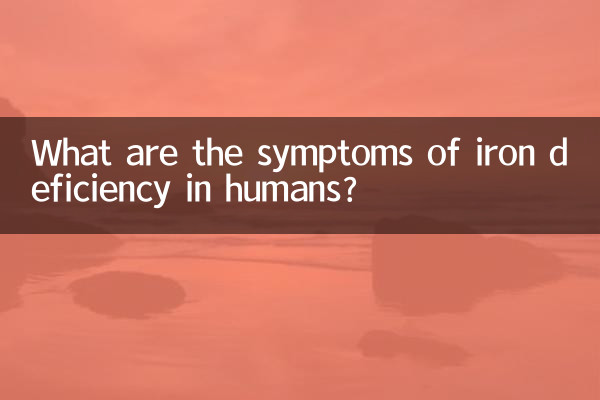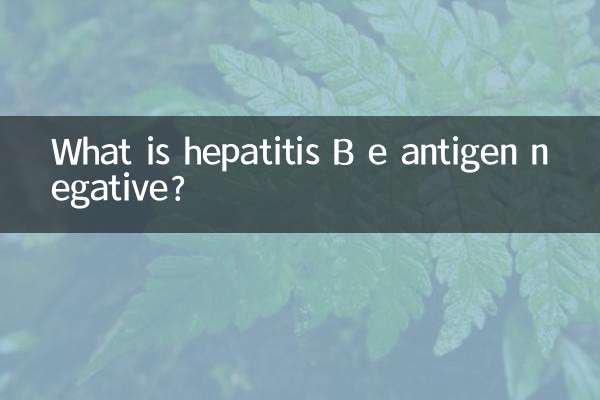What are the symptoms of iron deficiency in humans?
Iron deficiency is one of the common nutritional deficiencies, especially among women and children. Iron is an important component of the body's production of hemoglobin. Iron deficiency can lead to anemia and affect the normal functions of various body systems. Below are common symptoms and related data of iron deficiency.
1. Common symptoms of iron deficiency

Symptoms of iron deficiency vary from person to person, but here are some of the most common ones:
| symptom | describe |
|---|---|
| Fatigue | Due to insufficient hemoglobin, oxygen transport efficiency decreases, resulting in insufficient energy supply to the body. |
| dizzy | Insufficient oxygen supply to the brain may be accompanied by dizziness or dark vision when standing. |
| rapid heartbeat | The heart tries to make up for the lack of oxygen supply by pumping blood more often. |
| pale skin | Especially the face, nail beds and mucous membranes appear pale due to reduced hemoglobin. |
| Shortness of breath | You will feel difficulty breathing after slight activity, and your body will respiration faster due to lack of oxygen in the body. |
| cold hands and feet | Poor blood circulation leads to lower temperatures in the extremities. |
| pica | Some patients will want to eat non-food items, such as ice cubes, dirt, etc. |
2. High-risk groups for iron deficiency
The following groups of people are more likely to suffer from iron deficiency symptoms and need special attention:
| crowd | reason |
|---|---|
| pregnant woman | Fetal development requires large amounts of iron, and increased blood volume results in dilutive iron deficiency. |
| menstruating women | Menstrual blood loss leads to increased iron loss. |
| infants | Rapid growth and development require more iron, but the diet may not contain enough iron. |
| vegetarian | Iron absorption rates from plant foods are lower than from animal foods. |
| Chronic disease patients | Diseases such as gastrointestinal bleeding and kidney disease may cause iron absorption impairment or loss. |
3. Diagnosis and treatment of iron deficiency
If you suspect that you are iron deficient, you should seek medical examination promptly. Doctors usually diagnose by:
| Check items | normal range | Symptoms of iron deficiency |
|---|---|---|
| Hemoglobin (Hb) | Male:130-175g/L Women:115-150g/L | below normal |
| Serum iron | Male:11-30μmol/L Female:9-27μmol/L | reduce |
| ferritin | Men: 30-400μg/L Women:15-150μg/L | reduce |
| total iron binding capacity | 45-72μmol/L | rise |
Treatment for iron deficiency usually includes:
1.Diet modification:Increase your intake of iron-rich foods, such as red meat, animal liver, shellfish, dark green vegetables, etc.
2.Iron supplements:Your doctor may prescribe iron supplements, which are usually taken for 3-6 months to replenish iron stores.
3.Treat the underlying disease:If the iron deficiency is caused by another disease, the underlying disease needs to be treated at the same time.
4. Suggestions for preventing iron deficiency
Preventing iron deficiency is more important than treating it. Here are some practical prevention tips:
1. Eat a balanced diet to ensure adequate iron intake, especially for high-risk groups.
2. Vitamin C can promote the absorption of iron. Foods rich in iron can be paired with foods rich in vitamin C.
3. The polyphenols in tea and coffee can inhibit iron absorption and should be avoided with iron-rich foods.
4. Regular physical examinations, especially for pregnant women, children and women with heavy menstruation.
5. Seek medical attention promptly when symptoms of suspected iron deficiency appear, and do not blindly supplement iron on your own.
Although iron deficiency is common, it can be effectively prevented and treated through proper diet and lifestyle. If you suspect that you are iron deficient, it is recommended to seek medical treatment promptly and conduct diagnosis and treatment under the guidance of a doctor to avoid the possible side effects of self-supplementing iron.

check the details

check the details